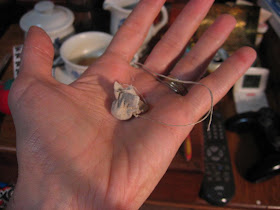
Phew! That action garb takes a lot outta ya!
(LOL)
 Penning a letter of protest 'gainst the tyranny of Henry, Lord Darnley "Does anyone know if 'doody head' is hyphenated?"
Penning a letter of protest 'gainst the tyranny of Henry, Lord Darnley "Does anyone know if 'doody head' is hyphenated?"  How would you like a nice career as an anatomist's skeleton?
How would you like a nice career as an anatomist's skeleton? Could I perhaps interest you in donating your body to science?
Could I perhaps interest you in donating your body to science? Staring pensively out over the approach hordes of... patrons!
Staring pensively out over the approach hordes of... patrons! Um, you know I can recommend a good poultice
Um, you know I can recommend a good poultice"An Englishman, endeavouring sometime to write of our attire, made sundry platforms for his purpose, supposing by some of them to find out one steadfast ground whereon to build the sum of his discourse. But in the end (like an orator long without exercise), when he saw what a difficult piece of work he had taken in hand, he gave over his travel, and only drew the picture of a naked man. Unto whom he gave a pair of shears in the one hand and a piece of cloth in the other, to the end he should shape his apparel after such fashion as himself liked, sith he could find no kind of garment that could please him any while together; and this he called an Englishman. Certes this writer (otherwise being a lewd popish hypocrite and ungracious priest) shewed himself herein not to be altogether void of judgment, sith the phantastical folly of our nation (even from the courtier to the carter) is such that no form of apparel liketh us longer than the first garment is in the wearing, if it continue so long, and be not laid aside to receive some other trinket newly devised by the fickle-headed tailors, who covet to have several tricks in cutting, thereby to draw fond customers to more expense of money."Full E-text of this invaluable resource is available from www.gutenberg.org
Please note: There are many places to learn to do this. Tudor Tailor has some instructions, as does the fantastic Renaissance Tailor website. Both are illustrated and both contributed in some fashion to me learning how to do this prior to posting this tutorial here. I'm putting this up not because it's never been done elsewhere, but because no one I've found has done this with actual step-by-step photos and even though illustrations are helpful, I've always found it more comforting undertaking something new to see it laid out in actual pictures. Keep in mind that I'm a trained illustrator when you read that. So here we go...

NOTE: when using a heavier fabric, such as canvas or even a wool flannel for this, you might want to nip off the edges and make a circle as shown below or it'll be too bulky later when the time comes to stuff it.


 Four
Four
 Six
Six
 Note the divot I carved into the tip of my wooden thimble in the picture above.
Note the divot I carved into the tip of my wooden thimble in the picture above.
 The more seams you have, the small pieces you piece from,
The more seams you have, the small pieces you piece from, Note the unaligned seams where the sleeve meets the doublet body.
Note the unaligned seams where the sleeve meets the doublet body. When easing curved seams I use as few pins as possible, giving me
When easing curved seams I use as few pins as possible, giving me
 'cuttes' across the toe-box. I'll probably do some small cuttes, but from past experience that makes for an odd, boxy fit for any shoe you do it to, so I plan to keep them small and to a minimum.
'cuttes' across the toe-box. I'll probably do some small cuttes, but from past experience that makes for an odd, boxy fit for any shoe you do it to, so I plan to keep them small and to a minimum.

